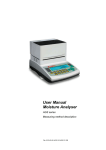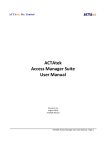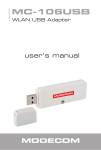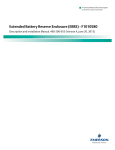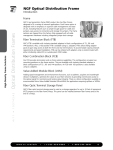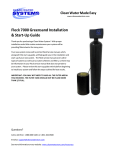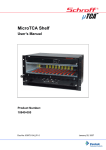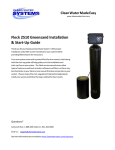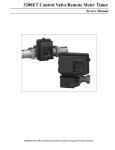Download AI-5120 User Guide - Advent Instruments
Transcript
AI-5120 Telephone Line Monitor User Guide Advent Instruments Inc. Release 1.2d Copyright 2011 - Advent Instruments Inc. All rights reserved. Printed in Canada Advent Instruments Inc. 111 - 1515 Broadway Street Port Coquitlam, BC, V3C6M2 Canada Internet: [email protected] [email protected] Web Site: http://www.adventinstruments.com Telephone: Fax: (604) 944-4298 (604) 944-7488 Safety Symbols and Terms ! When the symbol is present on an instrument it indicates that the operators should refer to the User Guide for more information. When the instrument. symbol is present it indicates a terminal that is connected to the functional ground of the When the symbol is present it indicates that the surface may be hot. Avoid contact with the surface of the instrument to avoid burns. When the symbol is present near a screw it should be connected to a safety earth ground using a wire recommended in the User Guide. Installation Categories Advent Instruments products are designed for use and to measure electrical signals that are rated Measurement Category I as described in the International Electrotechnical Commission (IEC) Standard IEC 606064. The equipment measurement terminals are not designed to be directly connected to the mains voltage or a voltage source with high transient over-voltages. Advent Instruments Inc. Contents Safety Symbols and Terms Installation Categories 1. Getting Started 1.1 Introduction 1.2 Package Contents 1.3 Important Safeguards and Safety Precautions 1.4 Powering on the AI-5120 1.5 Connecting to the PC 2. TRsSim Software 2.1 Introduction 2.2 For More Information 3. AI-5120 Instrument Suite 3.1 Introduction 3.2 For More Information 4. Technical Overview 4.1 Block Diagrams 4.2 Indicators & Connections 4.3 Specifications ii ii 1 1 2 3 3 4 6 6 9 10 10 12 13 13 15 18 5. Firmware Updates 20 Appendix A: USB Driver Installation 22 Appendix B: Error Codes 25 Appendix C: Support 27 AI-5120 User Guide i 1. Getting Started 1.1 Introduction The AI-5120 Telephone Line Monitor is a compact device designed to detect and analyze various telephony related signals. By sensing the voltage present on the telephone line it determines the line state (on hook, or off-hook) in addition to detecting common signals such as DTMF, FSK, and DC line voltage. Working in conjunction with the TRsSim software on a PC, the AI-5120 becomes a valuable tool in analyzing and debugging Caller ID and SMS (Short Message Service) data transmissions. Like an oscilloscope, the AI-5120 can capture and display waveforms showing the various signals present on the telephone line. However, unlike an oscilloscope, it can also automatically trigger on events specific to telephony. Some of the common events that the AI-5120 detects and analyzes are: • DTMF Dialing • FSK Caller ID and ETSI SMS Data • Pulse Dialing • Ringing • CAS/DTAS Tones • On/Off hook, Line Reversals, Open Switching Intervals (OSI) As a line monitor, the AI-5120 does not go off-hook (seize the line), or generate tones. It only listens. The impedance presented by the AI-5120 to the telephone line is over 10 Mohm. As such it has little to no effect on any signals present on the telephone line. The supplied TRsSim PC software provides a high level graphical user interface for controlling the AI-5120. As events are detected, the software displays timing and measurement information. In addition, waveforms for each event may be recorded for display and further analysis. Waveforms can be played back to the AI-5120's BNC monitor or speaker out, or exported as wave files for analysis using various software packages. The TRsSim software automatically decodes FSK based Caller ID conforming to the Telecordia, ETSI, and Japanese NTT standards. It displays the message contents at either a high level showing the parameter values, or at a low level showing each byte detected. Additionally, Short Message Service (SMS) following the ETSI ES 201 912 standard is supported. Details of each SMS FSK message can be displayed along with various signal measurements. Any signals present on the telephone line may be routed to the AI-5120's rear panel BNC output connector or speaker/headphone connector. This provides a simple means to pass signals to external equipment requiring an unbalanced input. A wide range of programmable filters can be inserted in the signal path helping to reject unwanted signals AI-5120 User Guide 1 1. Getting Started Advent Instruments Inc. and isolating the desired signals. Also available on the rear panel of the AI-5120 is a digital I/O connector. The three digital outputs can be used to notify external equipment when the telephone line goes off-hook, when ringing is detected and the decoded bit pattern from the FSK demodulator. By using the two digital inputs, external equipment can trigger the TRsSim software to record signals present on the telephone line. While the TRsSim software is included with every AI-5120, the optional AI-5120 Instrument Suite software converts the unit into a spectrum analyzer and digital storage oscilloscope. The spectrum analyzer operates over a 35 kHz bandwidth with features such as variable span, peak hold, averaging, and cursor measurements. The DSO portion of the software supports up to a 5 second memory depth in addition to programmable triggers, filters, and cursors. The AI-5120 connects to the PC via either a full speed (12 Mbit/s) USB 2.0 interface, or a legacy RS-232 communications port. While the TRsSim software functions with either interface, the use of the USB connection is strongly recommended due to the fast data transfer rates. The Instrument Suite software requires the USB connection. 1.2 Package Contents Use care when unpacking the AI-5120 to avoid damage to the instrument and the packing materials. Retain the packing materials in case the unit is to be transported in the future. Please inspect the shipping container and the contents for any damage. If visible damage is present, contact your local sales representative or Advent Instruments directly (see Appendix C: Support). Keep the shipping materials for the carrier inspection. The package should contain the following items: • AI-5120 Telephone Line Monitor • Full speed USB cable • Telephone Cord with RJ-11 Connectors • AC Power Adapter (plug type dependent on ordering part number) • CD-ROM containing TRsSim software, USB drivers, and Setup software • AI-5120 User Guide Manual • TRsSim User Guide Manual • Software License Key for TRsSim Application • Software License Key for AI-5120 Instrument Suite (*) • Calibration Certificate If any of the above items are missing, contact your local sales representative or Advent Instruments directly (see Appendix C: Support) for replacement. * 2 Note, the AI-5120 Instrument Suite (p/n: AI-SS100) is an optional software program, and not included as part of the basic AI-5120 package. AI-5120 User Guide 1.3 Important Safeguards and Safety Precautions Please read all instructions and save them for future use. Observe the following precautions to avoid injury and prevent damage to the AI-5120 or any products connected to it. The AI-5120 is intended for use by qualified personnel who recognize shock hazards and procedures to avoid possible electrical shock. The AI-5120 is designed for use with electrical signals that are rated Measurement Category I as described in IEC Standard 60664. All connectors and I/O are intended for connection to Category I sources unless otherwise described in the manual. • Insure the AC power source is compatible with the voltage and frequency requirements stated on the label of the supplied power adapter. • Do not operate the instrument with the case opened. • Do not allow any liquid to enter the interior of the instrument. • Observe all terminal ratings to avoid fire or shock hazards. • Avoid exposed terminals. Do not touch exposed connections when power is present. • Do not operate with suspected failures. If damaged is suspected, do not continue to operate the instruments until inspected by qualified service personnel. • Caution To reduce the risk of fire use only a No 26 AWG or larger telecommunications line cord • The instrument is intended for use in an indoor laboratory environment with an altitude not to exceed 2000m. (Pollution Degree 2) • To clean the instrument, disconnect it from the power supply, and then wipe down the exterior with a cloth dampened with a mixture of mild detergent and water. After the instrument is completely dry, the power supply may be re-connected. • Refer servicing to a trained personal only. 1.4 Powering on the AI-5120 Before powering on the AI-5120 for the first time, disconnect any cables connected to the unit. The supplied power adapter automatically adjusts to a wide range of input voltages and frequencies. However please ensure the AC voltage source is within the limits printed on the label. The AI-5120 does not have power switch. To turn the unit on, insert the 2mm plug from the supplied power adapter into the matching rear panel jack of the AI-5120. Then plug the power adapter into the mains AC socket. In order to turn off the unit remove the 2mm plug from the AI-5120. AI-5120 User Guide 3 1. Getting Started Advent Instruments Inc. RS-232 9V 300 mA DCE A single beep will be heard and all four front panel indicators should briefly illuminate for less than one second in duration. Following a short delay the "Ready" indicator should turn on and stay on. The other three indicators ("Communications", "Ringing", and "Off-Hook") should remain off. Once the "Ready" indicator is solidly on, the unit is ready for use. Line Ready Communication Ringing Off-Hook Bypass 300 V Peak CAT I A number of checks are performed during the power up cycle. If a fault is detected, the "Ready" indicator will either flash, or remain off. If it stays off, the fault is serious and may require that the unit be returned for repair or replacement. In either case, see Appendix B: Error Codes for more information and possible corrective action. 1.5 Connecting to the PC The AI-5120 can be connected to the PC by either its RS-232 port or USB 2.0 compliant full speed (12 Mbit/second) port. Both connectors are present on the rear panel of the unit. If using the TRsSim software with the AI-5120, the USB connection is strongly recommended because of its higher data rate. USB incurs less latency when sending commands and receiving the waveform data from the AI-5120. However either connection method operates reliably with the TRsSim software. USB Driver The proper drivers must be installed before a USB connection can be established between the AI-5120 and the PC. The WHQL USB driver files are automatically installed with the TRsSim application and no further steps should be required. If the end use does not require the TRsSim application then it is also possible to install the driver manually. For detailed step-by-step instructions on installing the driver, see Appendix A: USB Driver Installation. The following is a summary of the installation procedure described in the Appendix. 4 AI-5120 User Guide 1. Download the USB driver installation package from our website or from the CDrom. 2. Double click on the self extracting installer. This normally requires using the administrator privileges in Vista and Windows 7 3. The installer will decompress the files and prompt you through the steps to install the driver files. 5. A message should be displayed indicating the successful installation of the two driver files. RS-232 The rear panel 9 pin connector of the AI-5120 is configured as a DCE (Data Communications Equipment) port. As the PC is normally configured as a DTE (Data Terminal Equipment) port, a straight-though cable is required for the connection. Do not use a cross-over cable between the AI-5120 and the PC serial port. The AI-5120's RS-232 data transmissions are fixed at 8 data bits with 1 stop bit and no parity. The baud rate is adjustable from a default (at power up) setting of 9600 bps to a maximum of 115200 bps. If a break signal (at least 11 consecutive space bits) is detected by the AI-5120, it resets its baud rate to 9600 bps. Only three signals are required for communication. These are Tx Data, Rx Data, and Ground. The Request-to-Send (RTS) and Clear-To-Send (CTS) signals have no effect on communication. On the AI-5120's 9 pin RS-232 connector, the Data-Terminal-Ready (DTR) pin is directly wired to the DataSet-Ready (DSR) pin. As such, if the PC asserts DTR, it can read back that DSR is asserted as well. AI-5120 User Guide 5 2. TRsSim Software Advent Instruments Inc. 2. TRsSim Software 2.1 Introduction The TRsSim software provides a high level graphical user interface to the AI-5120. Operating under the Windows OS (XP, Vista, Windows 7), it controls the AI-5120 via either a USB or RS-232 serial connection. When using the TRsSim software, the AI-5120 is configured as an event recorder. This means it continually monitors the telephone line voltage for events such as on-hook or off-hook transitions, line flashes, pulse dialing, line polarity reversals, DTMF digit detection; CAS/DTAS tone detection, and FSK message detection. Once an event is detected, any applicable measurements are made and the signal waveform may be recorded. This information is then transferred to the PC where the TRsSim software is used to view and analyze the data. Each recorded waveform can range up to 20 seconds in duration. The TRsSim software can capture multiple waveforms encompassing a total monitoring time span of 1000 hours. The graphical representation of the AI-5120 is the main control panel. The TRsSim software can connect with more than one AI-5120, and each one is displayed in a separate control panel window. From this window, the current telephone line status is shown as well as the DC voltage and AC signal readings. In addition, any detected events are displayed, including their measurement details. From the control panel all of the settings for the AI-5120 are accessed, as well as viewing event data and waveforms. The figure below shows an example of the main control panel. 6 AI-5120 User Guide The top portion of the window displays the current line status and signal level. Both AC RMS level and DC line voltage are shown. AC signal frequency is displayed if sufficient signal level is present. Options exist to apply various signal filters (adjustable low pass, high pass, band pass, and notch) in order to minimize unwanted or interfering tones. The bottom half of the window shows the recorded events on a time line, along with the summary information of the events detected. In the example above, the time line is viewing a 4 second span showing a Caller ID message transmission. Both the time span and time position is adjustable by clicking on the appropriate buttons. The selected event in the example above is the detection of a Caller ID FSK message. The basic type of message is shown along with time intervals to prior and following events. While the window above shows the basic or summary information regarding the events detected, further analysis and information is provided by the Data Recorder window. In the following figure, portions of the captured waveforms for the Caller ID transmission are displayed. The AI-5120 records waveforms using two different channels. The first channel is DC coupled and provides a maximum range of +/- 300 volts. It is used for recording events such as ringing, on-hook, off-hook, line flash, and pulse dialing. The second channel is AC coupled with a range of 10 volts peak-to-peak. Sampling much faster than the DC coupled channel, it records the DTMF, FSK, and CAS/DTAS events. The figure above shows both channels during the example Caller ID transmission. The top half (DC coupled) of the window shows the ringing signal prior to the FSK message, while the bottom half (AC coupled) shows the FSK message. By clicking on the appropriate buttons, the vertical span, horizontal span, and position of the waveforms can be changed. In addition to displaying the captured waveform, the TRsSim software can present various reports showing more detailed information. This includes measurements for any DTMF digits, FSK message bytes, Caller ID parameter contents, and SMS message AI-5120 User Guide 7 2. TRsSim Software Advent Instruments Inc. contents. The following figure shows the FSK data layer report for the example Caller ID message. The TRsSim software includes additional features allowing captured waveforms to be exported as text or waveform (.wav) files. Waveforms can be played back to the BNC output connector, speaker output, or any installed PC audio sound card. Waveform Analysis Software Option: (AI-ET003) The TRsSim software can include an optional component that provides more advanced analysis tools. The Waveform Analysis option gives the TRsSim software the following abilities: 8 • Show byte and bit level decoding of any FSK waveforms • More detailed physical layer FSK signal measurements • More detailed DTMF signal measurements • Waveform filtering and adjustments • Waveform measurements AI-5120 User Guide Note: The Waveform Analysis features are an optional component to the TRsSim software program, and not part of the basic package. An example of the FSK byte and bit level decoding is shown in the following figure. As the recorded signal is zoomed in the window, addition information such as the byte and bit values are displayed. A physical layer analysis of the same Caller ID message yields additional information. The presented report is divided into three parts. The first presents timing information on the FSK signal. This includes the duration and number of bits or bytes of each section (channel seizure, mark, data, and mark-out) within the signal. The second part contains signal measurements such as mark/space tone level and frequency. Additionally the frequency spectrum during the mark interval is shown. This is used to extract information about any potential interfering signals. Finally, the third portion of the report provides a listing of each data byte detected. 2.2 For More Information Detailed information on the operation of the TRsSim software for the AI-5120 can be found in the "TRsSim - Telephone Line Monitor - User Guide" document. It shows how to install and setup the software along with more complete instructions on its use. This document is included with the AI-5120 package. As newer versions of the TRsSim software are made available, they are posted on our web site at: http://www.adventinstruments.com Along with software updates, the web site also contains the latest versions of any relevant documentation. For technical support regarding the AI-5120 or the TRsSim software, please contact us in any of the manners listed in Appendix C: Support. AI-5120 User Guide 9 3. AI-5120 Instrument Suite Advent Instruments Inc. 3. AI-5120 Instrument Suite 3.1 Introduction The AI-5120 Instrument Suite is a Windows software package allowing the AI-5120 Telephone Line Monitor to operate as a digital storage oscilloscope (DSO) and spectrum analyzer. The software enables the user to investigate the time domain and frequency domain representation of signals through an intuitive instrument like software interface. Note: The AI-5120 Instrument Suite (p/n: AI-SS100) is an optional software program, and not part of the basic AI-5120 package. The figure below shows an example of the oscilloscope capturing a DTMF digit generated by a telephone. Similar to a conventional oscilloscope, controls located at the right side of the window determine various settings such as vertical scale, horizontal time base, trigger conditions, and cursors. The DSO has a record depth of 5 seconds giving it the ability to capture long dialing or FSK messages, while still being able to zoom into the waveform for analyzing details. The key specifications for the DSO are presented in the following table: 10 Bandwidth 100Hz to 10kHz Accuracy* ± 0.2 dBV (100Hz to 10kHz) Maximum Capture Time 5 seconds AI-5120 User Guide Maximum Signal Level 4 Vrms (sine wave) Trigger Sources Signal In, Digital In A, Digital In B Trigger Modes Auto, Normal, Single Trigger Slopes Rising, Falling, Both Edges Measurements Frequency, Peak-Peak Voltage, RMS, Cycle RMS * Accuracy is specified with no signal filters engaged The spectrum analyzer can operate simultaneously with the DSO or by itself. Represented by a separate window, the figure below shows a spectrum of a DTMF digit generated by a telephone. Cursors 'A' and 'B' indicate the two dominant frequency components of the signal at 1208 and 698 Hz respectively. The controls to the right side of the window allow adjustment of the frequency span, center frequency, reference level, and acquisition settings. The spectrum analyzer accommodates a maximum span setting of 35 kHz. Additional features such as peak hold allow it to capture short transient like signals, while spectrum averaging assists in measuring noise levels or repetitive signals. The key specifications for the spectrum analyzer are as follows: Bandwidth 100Hz to 35kHz Accuracy* ±0.2 dB (100Hz to 10kHz) ±0.5 dB (10kHz to 35kHz) Maximum Signal Level 4 Vrms (sine wave) FFT Window Types Rectangular, Blackman, Hanning Frequency Span Settings (Hz) 35000, 19531, 9766, 7813, 4883, 3906, 2441, 1953, 1563, 976,781, 390, 312.5, 156.3, 62.5 Center Frequency Programmable (Note: not all center frequencies are available since negative frequencies and frequencies >35kHz will not be displayed) Other Features Peak Hold, Programmable Averaging * Accuracy is specified with Blackman windowing, and no signal filters engaged AI-5120 User Guide 11 3. AI-5120 Instrument Suite Advent Instruments Inc. 3.2 For More Information Detailed information regarding the operation of the software can be found in the "AI5120 Instrument Suite - Users Manual" document. It provides installation and setup instructions along with complete information on its use. This document is included with the software installation and can be accessed by selecting the User Manual command from the Help menu. As newer versions of the Instrument Suite software are made available, they are posted on our web site at: http://www.adventinstruments.com Along with software updates, the web site also contains the latest versions of any relevant documentation. For technical support regarding the AI-5120 or the Instrument Suite software, please contact us in any of the manners listed in Appendix C: Support. 12 AI-5120 User Guide 4. Technical Overview 4.1 Block Diagrams The AI-5120 Telephone Line Monitor consists primarily of a high impedance voltage amplifier connected to a digital signal processor via two analog-to-digital converters. By sensing the voltage present on the telephone line, the signal processor is able to determine the line state and perform measurements on various signals. The following figure shows the major functional blocks of the AI-5120. The voltage on the telephone line is measured by an amplifier presenting an input impedance greater than 10 Mohm to ground for each of the tip and ring leads. The high input impedance prevents the AI-5120 from affecting the signals present on the telephone line in any significant manner. Following the amplifier, the signals are split into two paths. Both signal paths continue through amplifier or buffer stages followed by analogto-digital conversion. However one of the signal paths is DC coupled while the other is AC coupled. The DC coupled channel can accommodate a voltage range of +/- 300 volts with a sample rate of approximately 1200 sample per second. This channel is primarily used for detecting DC line conditions (on/off hook, line flash, line reversals) and ringing. The second channel is AC coupled with a maximum voltage range of 10 volts peak-topeak and a much faster sampling rate of approximately 20,000 samples per second. The AC coupled channel is used for performing DTMF, CAS/DTAS, and FSK detection along with general purpose signal measurements. AC Coupled Channel BNC Output 600 DAC ADC DAC Line RJ-11 Jack Bypass 10M Signal Processing DSP Speaker Output RJ-11 Jack 10M ADC DC Coupled Channel Control & Supervisory Functions USB Port RS-232 Port Digital In/Out The digital samples from both AC and DC coupled channels are fed into the signal processing block. It performs all of the detection and measurement for ringing, DTMF, AI-5120 User Guide 13 4. Technical Overview Advent Instruments Inc. FSK, and CAS/DTAS signals. In addition the signal processing block can apply various filters to the AC coupled channel and measure the RMS level, frequency, and THD+N. Signals sensed from the telephone line may be routed to either the rear panel BNC output connector, or to the speaker output connector. The BNC monitor has an output impedance of 600 ohms and can source a maximum voltage level of 5 volts peak-to-peak. The speaker jack output is meant to drive either a speaker or headphone with an impedance in the range of 8 ohms to 32 ohms. Its maximum output level is 2.8 volts peak-to-peak. The next figure depicts the signal processing flow within the AI-5120. The source of all signal data is from either the DC coupled channel or AC coupled channel. Data from the DC coupled channel is routed to three functional blocks that perform line state detection, ringing detection & measurement, and wave form capture. The line state detection block determines if a connected TE is either in the off-hook or on-hook state. In addition it monitors the line for polarity reversals and open switching intervals. The ring detection block checks for the presence of ringing by measuring AC signal level and frequency. If a valid ringing frequency (10 to 100 Hz) and level (> 40 Vrms) is detected, the front panel "Ringing" indicator is illuminated. The last block in the DC coupled signal path manages the recording of waveforms. Upon detection of various events it stores waveforms into the AI-5120's internal memory. Normally the waveforms are only stored in the memory until they are uploaded to the PC by the TRsSim software. Line State Detection DC Coupled Channel Ring Det. & Meas. Waveform Capture Internal Memory 50 / 60 Hz Notch AC Coupled Channel BNC Output Waveform Capture DTMF Det. & Meas. FSK Det. & Meas. Speaker Output Prog. Filters CAS/DTAS Detect Freq. Counter RMS Level THD+N The AC coupled signal processing path operates independently from the DC coupled path. Prior to any signal detection and measurement, an optional 50 / 60 Hz notch filter may be applied. This filter helps to minimize the effect of any power line hum pickup. Following the optional filter, the signals flow to various detection and measurement blocks. These monitor the incoming data for DTMF, FSK (Bell 202 or V.23), and CAS/DTAS tones. If detected, any applicable measurements are made and events are issued to the TRsSim software. The waveform capture block is responsible for storing AC coupled waveforms in the AI-5120's internal memory. Unlike for the DC coupled channel, any stored AC coupled waveforms may be played back to either the BNC monitor output or speaker output jack. Following a programmable filter bank, the AI5120 performs continuous RMS level, frequency, and THD+N measurements. The filter bank contains a selection of programmable low pass, high pass, band pass, notch, and Cmessage weighted filters that may be placed in the signal path. 14 AI-5120 User Guide Both the rear panel BNC monitor output and speaker jack output can select signals from either before or after the programmable filter bank, or from recorded AC coupled signals stored in the AI-5120's internal memory. The gain of each output is adjustable over a wide range. 4.2 Indicators & Connections The AI-5120 front panel is quite simple and only contains four LED indicators and two telephone interface RJ-11 jack. The two left side indicators "Ready" and "Communication" show the status of the unit and communication activity respectively. Under normal operation the "Ready" indicator should be illuminated. If it is flashing an internal fault is detected. When the "Ready" indicator is flashing, the state of the "Ringing" and "Off-Hook" indicators determine the specific fault condition. See Appendix B: Error Codes for information describing the fault conditions and possible solutions. The communication indicator briefly flashes anytime data is either sent to the PC or received from the PC. Data transferred on either the USB or RS-232 causes the indicator to flash. Line Ready Communication Communication with Host Unit Ready Ringing Off-Hook Bypass 300 V Peak CAT I Terminal Equipment Off-Hook Ringing Detected RJ-11 Connectors Tip/Ring Interface When the "Ready" indicator is illuminated (no fault condition), then the two right side LED's show when the AI-5120 has detected ringing or when the line state is in the offhook condition. Ringing is detected if an AC voltage exceeding 40 Vrms with a frequency in the range of 10 to 100 Hz. is measured. The AI-5120 considers the line state to be off-hook if the measured voltage is below a specified threshold (by default 19 volts) A telephone line can be connected to either of the AI-5120 front panel RJ-11 jack, as they are configured in parallel to each other. Typically, the telephone line from the central office, PBX, or line simulator is connected to one of the RJ-11 jacks, while the terminal equipment is connected to the other RJ-11 jack. AI-5120 User Guide 15 4. Technical Overview Advent Instruments Inc. Line Bypass 300 V Peak CAT I Terminal Equipment CO Line The next figure shows the configuration of the AI-5120 rear panel. The right most 2 mm jack supplies DC power to the unit. The connection to the PC (or any other host) is made via either the USB type B connector or the 9 pin RS-232 connector. It is possible to transfer data to the AI-5120 over both the USB and RS-232 ports simultaneously. However the TRsSim software is configured to only use one of the two ports. The 9 pin RS-232 connector is configured as a DCE (Data Communications Equipment). As such no cross over cable is required when making a connection to a standard PC serial port. A minimum of three wires are required to make a serial connection. They are TX Data (pin 2), RX Data (pin 3), and Ground (pin 5). The AI-5120 can monitor the PC's RTS (pin 7) signal and control the state of the CTS (pin 8) signal, but does not use them to communicate. The DSR (pin 6) and DTR (pin 4) connections are internally tied together. The remaining pins (1 and 9) have no internal connection. Advent Instruments Inc. www.adventinstruments.com Monitor Digital In/Out Made in Canada USB RS-232 9V 300 mA Gnd oA oB oC iA iB Speaker 2 Vrms 600 ohms DCE The BNC output connector can be used to monitor signals from the telephone line. Its source impedance is 600 ohms with a maximum output level of 5 Volts peak-to-peak. The 3 mm mono speaker jack to the left of the BNC monitor output performs a similar function, and can drive a speaker or headphone directly. The load impedance should be in the range of 8 to 32 ohms. Both the BNC output connector and mono audio jack have adjustable output gain and are controlled from the TRsSim software To the right of the BNC connector is a 6 pin terminal block. This connector provides 3 general purpose digital outputs and 2 general purpose digital inputs. The sixth pin provides a ground connection to the AI-5120. The three digital outputs (A, B, C) are in an open collector configuration. They can each sink up to 25 mA and are pulled high to +5 volts with a 5.1 kohm resistor. All three digital outputs can be set either high or low. An additional setting permits output A to mirror the bit pattern decoded by the FSK demodulator, output B to go high if ringing is detected, and output C to go high if the connected TE enters the off-hook state. The two digital inputs (A, B) have an input impedance of 100 kohm. The maximum input level to detect a logic low is 0.8 volts, while the minimum level to detect a logic high is 2.0 volts. 16 AI-5120 User Guide 4.3 Extended Product Support and Warranty AI-K001 Additional One Year Warranty The standard product support and warranty period for the instruments is one year. This option increases the parts and labor warranty period for another year to a total of two years from date of purchase on the instrument. AI-K003 Additional Three Year Warranty The standard product support and warranty period for the instruments is one year. This option increases the parts and labor warranty period for another three years to a total of four years from date of purchase on the instrument. AI-5120 User Guide 17 4. Technical Overview Advent Instruments Inc. 4.4 Specifications Telephone Interface: General: Input Impedance (tip to ring) Input Impedance (tip or ring to ground) Input Voltage Range Connector Style DC Coupled Channel: Voltage Measurement Accuracy Frequency Range Frequency Response Waveform Capture Rate > 20 MΩ > 10 MΩ ± 300 Volts Maximum. RJ-11 (only center two conductors used) ± 1% of reading, ± 0.2 Volts DC to 100 Hz ± 0.2 dB (up to 100 Hz) ≈ 1.2 ksample/s at 16 bits/sample AC Coupled Channel: Voltage Measurement Range Frequency Range Frequency Response Frequency Measurement Accuracy Common Mode Rejection Ratio Waveform Capture Rate ≤ 10 Vp-p Maximum 100 Hz to 18 kHz ± 0.2 dB (100 Hz to 10 kHz) 0.1% ± 1 Hz (100 Hz to 10 kHz) ≥ 55 dB at 60 Hz ≈ 20 ksample/s at 16 bits/sample Input & Output: BNC Output: Unbalanced, Ground Referenced Output Impedance Output Level Frequency Range Frequency Response Signal Source 600 Ω, ± 3% 5 Vp-p Maximum 10 Hz to 18 kHz ± 0.2 dB (50 Hz to 10 kHz) Tip/Ring, Tip/Ring with user selectable filters Speaker Output: Unbalanced, Ground Referenced Output Level Load Resistance Frequency Range Frequency Response Signal Source 2.8 Vp-p Maximum 8 Ω to 32 Ω 100 Hz to 18 kHz ± 0.75 dB (100 Hz to 10 kHz) Tip/Ring, Tip/Ring with user selectable filters Digital I/O: Number of Output Pins 18 Output Pin Configuration Output Pin Maximum Sink Current Output Pin Pull-up Resistance 3 (can be set to mirror hook detect status, ring detect status, and FSK decoder output status) Open Collector 25 mA 5.1 kΩ Number of Input Pins Input Pin Impedance Input Pin Low Level Input Input Pin High Level Input 2 100 kΩ 0.8 Volts (for logic 0) Maximum 2.0 Volts (for logic 1) Minimum AI-5120 User Guide Other: Host Communication: USB Port USB Connector RS-232 Configuration RS-232 Connector Version 2.0, Full Speed (12 Mbit/s) Standard Type-B DCE (Data Communication Equipment) 9 pin D style connector AC Line: Voltage Frequency 100 to 240 Vrms 50 to 60 Hz Physical: Dimensions Weight Operating Temperature Range Storage Temperature Range Operating Altitude AI-5120 User Guide Width: 14 cm (5.5") Height: 4 cm (1.6") Depth: 20 cm (8.0") ≈ 680 g (1½ lbs) 5 to 40 ºC, 80%RH -25 to 70 ºC, 80%RH ≤ 2000 m 19 5. Firmware Updates Advent Instruments Inc. 5. Firmware Updates The AI Firmware Update program provides a simple means of updating all of the system files stored in the AI-5120's internal flash memory. The software can be used to upgrade the system files to the latest version and correct device specific problems if the AI-5120's flash memory becomes corrupted. The program is available from the included CD or from our web site at: http://www.adventinstruments.com Once the AI Firmware Update software is installed on a PC, connect the AI-5120 to one of its COM ports. Power the AI-5120 on and start the firmware update software. The software will ask if it should query our website for latest updates. It is recommended to click yes to ensure the latest firmware is utilized. Once the update, if available, is downloaded the software checks for all compatible devices connected to the PC. Once this is complete a window appears (as shown below) displaying all the connected devices. For each device, its current firmware revision is shown along with the newest versions that may be installed. An older version of the firmware may be installed by clicking on the right most firmware selection icon. 20 AI-5120 User Guide The check box to the left determine which devices are to be updated. By ensuring it is checked and clicking on the Update Units button, the process of installing the selected firmware begins. Note: It is important NOT to shut off the power during the update process as this may permanently corrupt the memory of the device. Once the update process is complete and no errors were detected, a green icon is shown to the left of the device information. If the update could not be completed due to errors, a message providing information on the error is displayed. Please contact us for assistance in resolving the error. AI-5120 User Guide 21 Appendix A: USB Driver Installation Advent Instruments Inc. Appendix A: USB Driver Installation The WHQL certified driver files are automatically installed along with the TRsSim application and the following procedure should only be required if the end application will not use the TRsSim software. The drivers may be installed manually by using the add remove hardware wizard or via the self extracting installer package. The following figures show the step by step procedure for installing the USB drivers with this installer package. 1. Download the USB installer Package The USB installer package can be downloaded from our website at the following page http://www.adventinstruments.com/Downloads/ or copied from the original CDrom provided with the instrument. 22 AI-5120 User Guide 2. Run the USB installer Package Once the file is located on the target computer double click on the file to start the self extraction and the following window will be displayed. 3. Click on the Next button to install the driver files Windows will now copy the driver files from the installer package to the target computer. AI-5120 User Guide 23 Appendix A: USB Driver Installation 4. Advent Instruments Inc. Confirm the Driver installed correctly Once Windows has completed the installation of the driver files the following window marks beside both of the listed will display the results. Confirm that there are two driver names. 5. Click on the Finish button to exit the installer The driver is now installed and you may connect the instrument to the PC via a USB cable. 6. Connect the Instrument to the PC via the USB cable The following brief popup bubble will appear indicating Windows has detected the new instrument. Then a short time later the following popup will appear and the instrument is recognized by Windows and the PC. 24 AI-5120 User Guide Appendix B: Error Codes Various AI-5120 error conditions may be detected at power on or during operation. If such a condition is detected, the "Ready" indicator starts to flash from its normally solid on state. The type of error detected is determined by examining the state of the "Ringing" and "Off-Hook" indicators. The following table lists the various error conditions. READY Indicator Flashing Flashing Flashing Flashing Flashing Flashing AI-5120 User Guide RINGING Indicator On On Off Flashing Flashing Flashing OFF-HOOK Indicator On Flashing Off Flashing Off On Description / Corrective Measure RAM Test Failure: Upon power on a check of the system RAM is performed. This error code indicates that one or more data bytes did not pass the check. As this represents a hardware fault, the only corrective action is to return the unit for repair. Flash Memory Corruption Can Not Load Calibration: The calibration factors are missing from the flash memory or are corrupted. If the Ai5120Update.exe program has been used at least once after the last calibration, execute it again. It should be able to restore the missing data. If not, please contact technical support for assistance. Flash Memory Corruption No Program File: The primary DSP application program is missing from the flash memory or is corrupted. Use the Ai5120Update.exe program to restore the flash memory contents. Flash Memory Corruption No Startup Script File: The startup script file is missing from the flash memory or is corrupted. Use the Ai5120Update.exe program to restore the flash memory contents. Flash Memory Corruption Missing Unit ID Code: The unit ID code stored in the flash memory is either missing or is corrupted. If the Ai5120Update.exe program has been used at least once after the last calibration, execute it again. It should be able to restore the missing data. If not, please contact technical support for assistance. Flash Memory Corruption Missing Parameter Data File: The parameter data file is missing from the flash memory or is corrupted. Error Code 1004 1005 n/a 1008 1006 1007 25 Appendix B: Error Codes Very Fast Flashing Advent Instruments Inc. Very Fast Flashing Very Fast Flashing If the Ai5120Update.exe program has been used at least once after the last calibration, execute it again. It should be able to restore the missing data. If not, please contact technical support for assistance. Program Stack Fault The AI-5120 software has encountered a software stack fault. This error prevents the AI-5120 from responding to any commands and effectively freezes the system. n/a The power must be turned off and on in order to restore normal operation. Please contact technical support if this error occurs. It represents a software problem and should be corrected. The following error code is a special case in which the "Ready" indicator is not flashing. This error can only occur shortly after the AI-5120 is powered on. READY Indicator Off RINGING Indicator Off OFF-HOOK Indicator Off Description / Corrective Measure Flash Memory Corruption Failure to execute program: The primary DSP application program could not be started. This may indicate a corrupted file within the flash memory, or a hardware fault. Error Code n/a Use the Ai5120Update.exe program to restore the flash memory contents. If this fails to work, please contact technical support for assistance. 26 AI-5120 User Guide Appendix C: Support For assistance in hardware setup, program installation, software operation, or general questions, please contact us in any of the following methods. • Email: Technical Questions: [email protected] Sales Inquires: [email protected] • In North America: Tel: (604) 944-4298 Fax: (604) 944-7488 Mail: Advent Instruments Inc. 111 - 1515 Broadway Street Port Coquitlam, BC, V3C6M2 Canada • In Asia: Tel: (852) 8108-1338 Fax: (852) 3909-2338 Mail: Advent Instruments (Asia) Ltd. Unit 42, 18/F., Block D Wah Lok Industrial Centre, Phase II 31 / 35 Shan Mei Street Fotan, Shatin, New Territories, Hong Kong AI-5120 User Guide 27 Appendix C: Support Advent Instruments Inc. RoHS Self-Declaration Advent Instruments Inc., hereby declares that products listed below conform to the European Union's Restriction of Use of Hazardous Substances in Electrical and Electronic Equipment (RoHS) Directive2002/95/EC. The RoHS Directive restricts the use of certain substances including lead, mercury, cadmium, hexavalent chromium and certain halogenated flame retardants such as PBB and PBDE in electrical and electronic equipment. Advent Instruments products will have less than the RoHS limits stated below for the six restricted use substances. Restricted Substance List: Substance Cadmium (Cd) Lead (Pb) Mercury (Hg) Hexavalent Chromium (Cr6+) Polybrominated Biphenyls (PBB) Polybrominated Diphenyl Ethers (PBDE) Maximum Limit (Weight) 100 ppm 1000 ppm 1000 ppm 1000 ppm 1000 ppm 1000 ppm Product list: Model AI-5120 AI-5620 AI-7280 Description Line Monitor Terminal Equipment Simulator Central Office Line Simulator David Stenner Advent Instrument Inc. 28 Date: Jan 21, 2007 AI-5120 User Guide
































